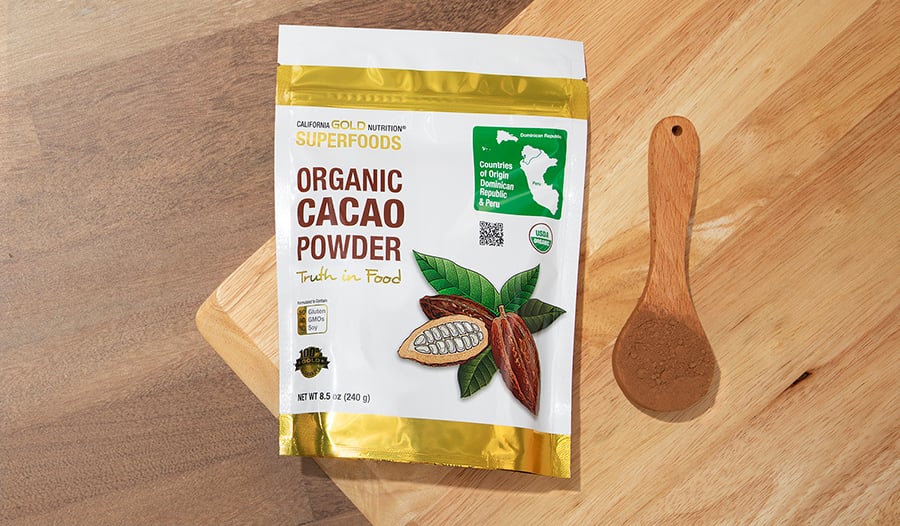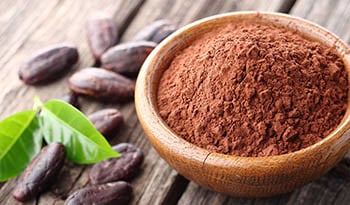Unwrapping Cacao’s Chocolatey Antioxidant and Mood Benefits
DISCLAIMER:This blog does not intend to provide diagnosis...
- In this article:
- The History of Cacao
- What Makes Cacao a Superfood?
- Is Cacao High In Polyphenols?
- Does Cacao Contain Methylxanthine?
- What Other Bioactive Compounds Does Cacao Contain?
- Cacao’s Mental Health Benefits
- Conclusion

The History of Cacao
Cacao is the seeds from the small evergreen tree Theobroma cacao, used to make cocoa, cocoa butter, and chocolate. Native to South America, cacao was domesticated by the Maya and cultivated in Central America. The word cacao traces back further to the Olmec, a civilization based around the southern edge of the Gulf of Mexico. Most likely, the Aztecs co-opted a number of Mayan beliefs about cacao and used the beans in numerous types of rituals and ceremonies. At the time, only males of high stature or, occasionally, human sacrifices were allowed to imbibe cacao in any form.
In the 1500s, European explorers began encountering cacao and cacao consumption throughout Mesoamerica. Presented to the Spanish court as a beverage in 1544, cacao spread as a beverage and medicine throughout Western Europe over the next century. As demand for cacao increased, plantations were created to cultivate and grow cacao beans for the burgeoning European market.
Cacao's use and spread are similar to two other popular beverages containing caffeine: tea and coffee. While chocolate is often considered junk food, cacao was historically revered for its medicinal properties. More recently, research into chocolate, cocoa, and cacao has begun to resurface the potential value of chocolate and cacao as medicine.
What Makes Cacao a Superfood?
Cacao beans are now often considered a superfood. The beans contain significant carbohydrates, fat, protein, and fiber levels. In addition, cacao has a number of constituents that likely influence its potential medicinal benefits, including polyphenols, methylxanthines, and other bioactive constituents.
Is Cacao High In Polyphenols?
A growing number of herbs are being recognized for benefits potentially derived from their polyphenol content. Turmeric, green tea, pine bark extract, and grape seed are all rich in polyphenols. All these herbs are under active investigation, with research suggesting potential mental and physical health effects.
Similarly, cacao is also increasingly recognized as an herb rich in polyphenols.
Polyphenols are compounds that often give plants their deep colors. These compounds are also notable for being potent antioxidants and displaying potential anti-inflammatory benefits. The polyphenols in chocolate, in particular, appear to benefit the heart. Preliminary evidence suggests that regular consumption of dark chocolate may help to decrease problematic blood clotting, reduce blood pressure, balance blood sugar, increase “good” high-density lipoprotein (HDL) cholesterol, and reduce “bad” low-density lipoprotein (LDL) cholesterol. For heart disease, LDL cholesterol primarily becomes a risk factor when damaged or oxidized. The polyphenols in cacao have also been shown to help prevent LDL oxidation.
But the benefits of cacao polyphenols don’t end there. They also appear to play a role in brain health. Although the research is mostly in animals, it suggests that the polyphenols in cacao have antioxidant effects that may improve aspects of learning, memory, and cognition. The polyphenols in chocolate have also been shown to cross the blood-brain barrier and increase blood flow.
Other benefits from cacao polyphenols include increased brain-derived neurotrophic factor (BDNF). BDNF is a growth factor that encourages new brain cell growth and development. It is also hypothesized to play a role in helping to reduce depressive symptoms. Considering the potential benefits of chocolate polyphenols, it’s not surprising that cacao is being promoted as an anti-aging supplement.
Does Cacao Contain Methylxanthine?
Methylxanthines include caffeine and related compounds found in chocolate, tea, guarana, and coffee, among other sources. While the main methylxanthine in chocolate is theobromine, it also contains significant amounts of caffeine.
Methylxanthines are well known for their energy-producing effects. Methylxanthines provide energy mainly through their effects on adenosine receptors in the central nervous system. Adenosine receptors have a number of functions but also play a cardinal role in causing tiredness and fatigue. Adenosine triphosphate (ATP) provides energy for cells. As that energy is used up throughout the day, adenosine is left over. As adenosine levels increase, you begin to feel tired.
Methylxanthines don’t give you more energy; they work by inhibiting your experience of fatigue by blocking adenosine receptors. Adenosine receptors also have effects on the heart and lungs, the latter of which is likely why chocolate found some historical use in the treatment of asthma.
Based on these effects, methylxanthines have been shown to boost mood, energy levels, and concentration. In one study, researchers showed that the isolated methylxanthines were the primary source of mood and energizing effects from chocolate. The researchers compared raw cocoa consumption with purified methylxanthines. The mood and energizing effects were virtually identical.
What Other Bioactive Compounds Does Cacao Contain?
Also present in chocolate are a number of other potentially bioactive compounds. These compounds include phenylethylamine and anandamide.
Phenylethylamine
Phenylethylamine modulates the effects of other neurotransmitters (like dopamine and serotonin) while acting as a neurotransmitter. It is generally thought that phenylethylamine acts as a stimulant, increasing energy levels and improving mood. Other research has potentially linked the compound to cognition and memory function, as well as with the prevention of a number of mental health conditions, including depression and Parkinson’s disease. There are claims that phenylethylamine may be one of the constituents that makes chocolate an aphrodisiac, although this claim is far from proven.
Anandamide
Anandamide was the first endocannabinoid discovered in the human body. In other words, anandamide is the first compound known to be produced by the body that stimulates the same receptors as tetrahydrocannabinol (THC) from cannabis. Scientists have postulated that anandamide could be part of the pleasure and appeal of chocolate and cacao through interactions with the cannabinoid system. It also could contribute to the addictive nature of chocolate, although more research is needed since levels of anandamide are fairly low.
Cacao’s Mental Health Benefits
Although the research hasn’t been entirely consistent, there are still strong suggestions that cacao may have some significant mental health benefits.
A recent study administered dark chocolate or white chocolate to a group of young adults for 30 days. Dark chocolate enhanced cognition and raised levels of nerve growth factor, a growth factor involved in supporting the growth and development of brain cells. Interestingly, the cognitive benefits held for at least three weeks after dark chocolate consumption ended.
In a separate study, healthy young adults were given either 70% dark chocolate, 85% dark chocolate, or no chocolate for three weeks. While 85% dark chocolate improved mood, the 70% dark chocolate was not found to be of benefit for mood states. Analysis of the gastrointestinal microbiota of the study subjects found that the 85% dark chocolate produced beneficial changes in the microbiota, or gut flora. In subjects consuming the 85% dark chocolate, increased diversity of beneficial bacteria was found along with an increased level of a specific bacteria that both may have been part of the beneficial effects on mood.
Other research suggests increased calmness and contentment with dark chocolate consumption. Study participants were given a dark chocolate beverage with differing amounts of polyphenols. In those subjects given the highest dose over 30 days, calmness and contentedness were significantly increased. Similarly, in subjects prone to anxiety, evidence suggests that chocolate may help decrease anxiety levels.
A study in older subjects given chocolate, red berries, or both found improvements in executive function. Executive function is generally considered to have three components: working memory, flexibility in thinking, and self-control.
In a small study, subjects with chronic fatigue were given a high polyphenol chocolate beverage or placebo for eight weeks. When the patients were on the real chocolate beverage, overall symptoms of chronic fatigue were reduced by one-third. In addition, anxiety scores were also reduced by one-third, with depression scores improving by almost one-half.
While most previous studies evaluated the daily, long-term consumption of chocolate, a study on the acute effects also hints at benefits. Subjects who consumed a single dose of a high-polyphenol chocolate beverage performed better on cognitive-demand testing.
Conclusion
Cacao contains numerous components that display antioxidant properties and may benefit mental health and cognition. Other research also suggests that chocolate and cacao have potentially positive effects on heart health and blood sugar levels. While more research is clearly needed, the best results for supporting mental health are likely seen with darker chocolate varieties containing higher levels of active constituents. Considering how much chocolate and cacao are often enjoyed as snacks or sweet treats, it’s nice to know that utilized properly, they may also provide significant health benefits.
References:
- Dala-Paula BM, Deus VL, Tavano OL, Gloria MBA. In vitro bioaccessibility of amino acids and bioactive amines in 70% cocoa dark chocolate: what you eat and what you get. Food Chem. 2021;343:128397. doi:10.1016/j.foodchem.2020.128397
- Devaraj S, Vega-López S, Kaul N, Schönlau F, Rohdewald P, Jialal I. Supplementation with a pine bark extract rich in polyphenols increases plasma antioxidant capacity and alters the plasma lipoprotein profile. Lipids. 2002;37(10):931-934. doi:10.1007/s11745-006-0982-3
- Di Marzo V, De Petrocellis L, Fezza F, Ligresti A, Bisogno T. Anandamide receptors. Prostaglandins Leukot Essent Fatty Acids. 2002;66(2-3):377-391. doi:10.1054/plef.2001.0349
- di Tomaso E, Beltramo M, Piomelli D. Brain cannabinoids in chocolate. Nature. 1996;382(6593):677-678. doi:10.1038/382677a0
- Dillinger TL, Barriga P, Escárcega S, Jimenez M, Salazar Lowe D, Grivetti LE. Food of the gods: cure for humanity? A cultural history of the medicinal and ritual use of chocolate. J Nutr. 2000;130(8S Suppl):2057S-72S. doi:10.1093/jn/130.8.2057S
- Gratton G, Weaver SR, Burley CV, et al. Dietary flavanols improve cerebral cortical oxygenation and cognition in healthy adults. Sci Rep. 2020;10(1):19409. Published 2020 Nov 24. doi:10.1038/s41598-020-76160-9
- Hii CL. Law CL. Suzannah S. Misnawi, Cloke M. Polyphenols in cocoa (Theobroma cacao L.). Asian Journal of Food and Agro-Industry. 2009;2(4):702-722.
- Jin T, Song Z, Weng J, Fantus IG. Curcumin and other dietary polyphenols: potential mechanisms of metabolic actions and therapy for diabetes and obesity. Am J Physiol Endocrinol Metab. 2018;314(3):E201-E205. doi:10.1152/ajpendo.00285.2017
- Kim HS, Quon MJ, Kim JA. New insights into the mechanisms of polyphenols beyond antioxidant properties; lessons from the green tea polyphenol, epigallocatechin 3-gallate. Redox Biol. 2014;2:187-195. Published 2014 Jan 10. doi:10.1016/j.redox.2013.12.022
- Loor Solorzano RG, Fouet O, Lemainque A, et al. Insight into the wild origin, migration and domestication history of the fine flavour nacional Theobroma cacao L. variety from Ecuador [published correction appears in PLoS One. 2013;8(2). doi:10.1371/annotation/2357f0f1-7dc3-4781-afb0-29a8ce56b3f0]. PLoS One. 2012;7(11):e48438. doi:10.1371/journal.pone.0048438
- MPhil EA. Cocoa and chocolate consumption – are there aphrodisiac and other benefits for human health? S Afr J Clin Nut. 2008;21(3).
- Martin FP, Antille N, Rezzi S, Kochhar S. Everyday eating experiences of chocolate and non-chocolate snacks impact postprandial anxiety, energy and emotional states. Nutrients. 2012;4(6):554-567. doi:10.3390/nu4060554
- Pase MP, Scholey AB, Pipingas A, et al. Cocoa polyphenols enhance positive mood states but not cognitive performance: a randomized, placebo-controlled trial. J Psychopharmacol. 2013;27(5):451-458. doi:10.1177/0269881112473791
- Pucciarelli DL, Grivetti LE. The medicinal use of chocolate in early North America. Mol Nutr Food Res. 2008;52(10):1215-1227. doi:10.1002/mnfr.200700264
- Sathyapalan T, Beckett S, Rigby AS, Mellor DD, Atkin SL. High cocoa polyphenol rich chocolate may reduce the burden of the symptoms in chronic fatigue syndrome. Nutr J. 2010;9:55. Published 2010 Nov 22. doi:10.1186/1475-2891-9-55
- Scholey AB, French SJ, Morris PJ, Kennedy DO, Milne AL, Haskell CF. Consumption of cocoa flavanols results in acute improvements in mood and cognitive performance during sustained mental effort. J Psychopharmacol. 2010;24(10):1505-1514. doi:10.1177/0269881109106923
- Shi J, Yu J, Pohorly JE, Kakuda Y. Polyphenolics in grape seeds-biochemistry and functionality. J Med Food. 2003;6(4):291-299. doi:10.1089/109662003772519831
- Shin JH, Kim CS, Cha L, et al. Consumption of 85% cocoa dark chocolate improves mood in association with gut microbial changes in healthy adults: a randomized controlled trial. J Nutr Biochem. 2022;99:108854. doi:10.1016/j.jnutbio.2021.108854
- Smit HJ, Gaffan EA, Rogers PJ. Methylxanthines are the psycho-pharmacologically active constituents of chocolate. Psychopharmacology (Berl). 2004;176(3-4):412-419. doi:10.1007/s00213-004-1898-3
- Sokolov AN, Pavlova MA, Klosterhalfen S, Enck P. Chocolate and the brain: neurobiological impact of cocoa flavanols on cognition and behavior. Neurosci Biobehav Rev. 2013;37(10 Pt 2):2445-2453. doi:10.1016/j.neubiorev.2013.06.013
- Sumiyoshi E, Matsuzaki K, Sugimoto N, et al. Sub-chronic consumption of dark chocolate enhances cognitive function and releases nerve growth factors: a parallel-group randomized trial. Nutrients. 2019;11(11):2800. Published 2019 Nov 16. doi:10.3390/nu11112800
- Tan TYC, Lim XY, Yeo JHH, Lee SWH, Lai NM. the health effects of chocolate and cocoa: a systematic review. Nutrients. 2021;13(9):2909. Published 2021 Aug 24. doi:10.3390/nu13092909
- Verna R. The history and science of chocolate. Malays J Pathol. 2013;35(2):111-121.
- Zięba K, Makarewicz-Wujec M, Kozłowska-Wojciechowska M. Cardioprotective mechanisms of cocoa. J Am Coll Nutr. 2019;38(6):564-575. doi:10.1080/07315724.2018.1557087

 By Dr. Scott Buesing, N.D.
By Dr. Scott Buesing, N.D.


